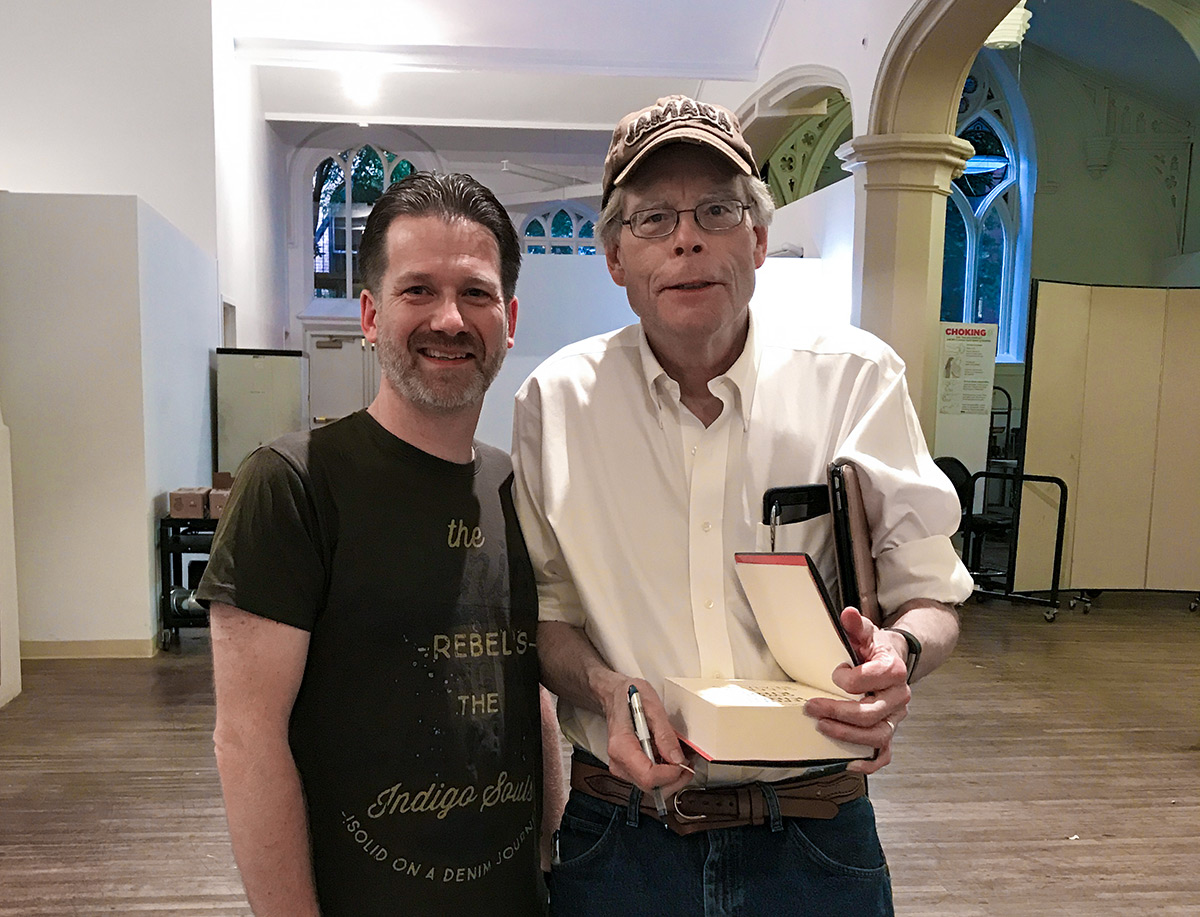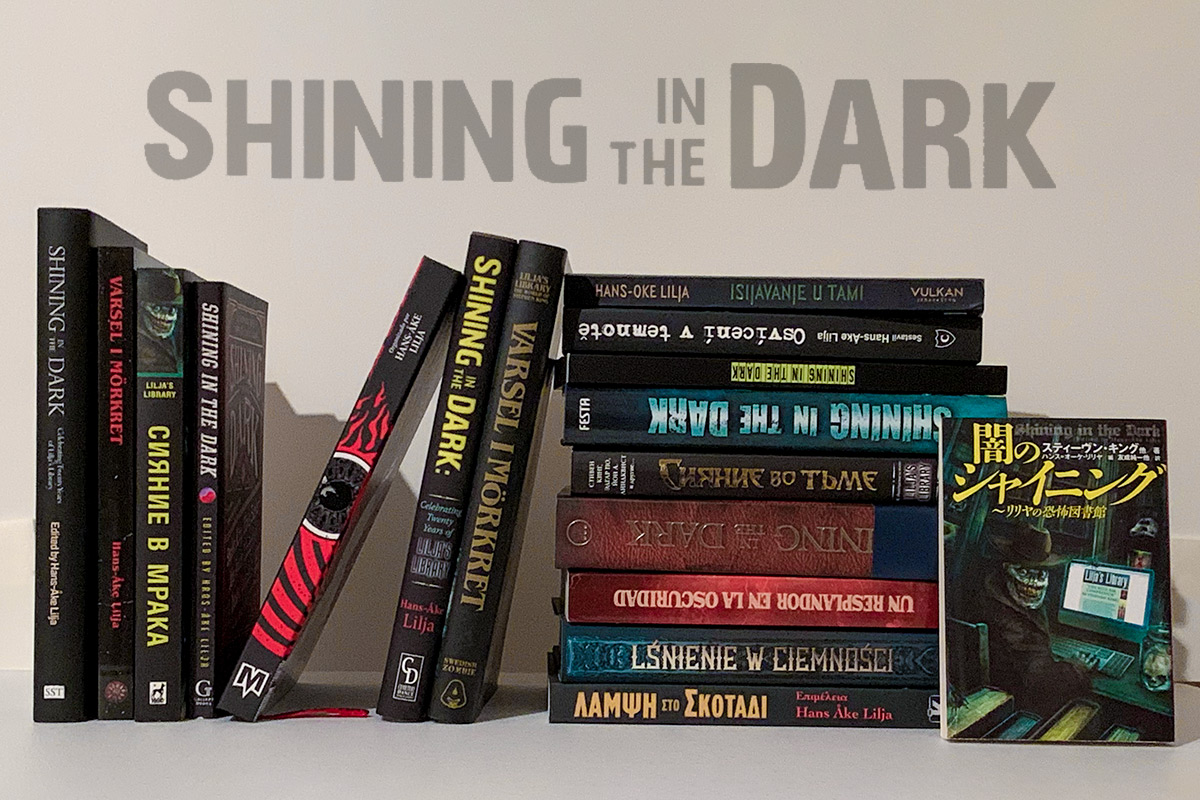Bachman - An Explanation
Richard Bachman - An Explanation
Richard Bachman is an author who never existed. Or who does exist, of course, but whose real name is Stephen King, while the name Richard Bachman is just as made up as everything else about Bachman.
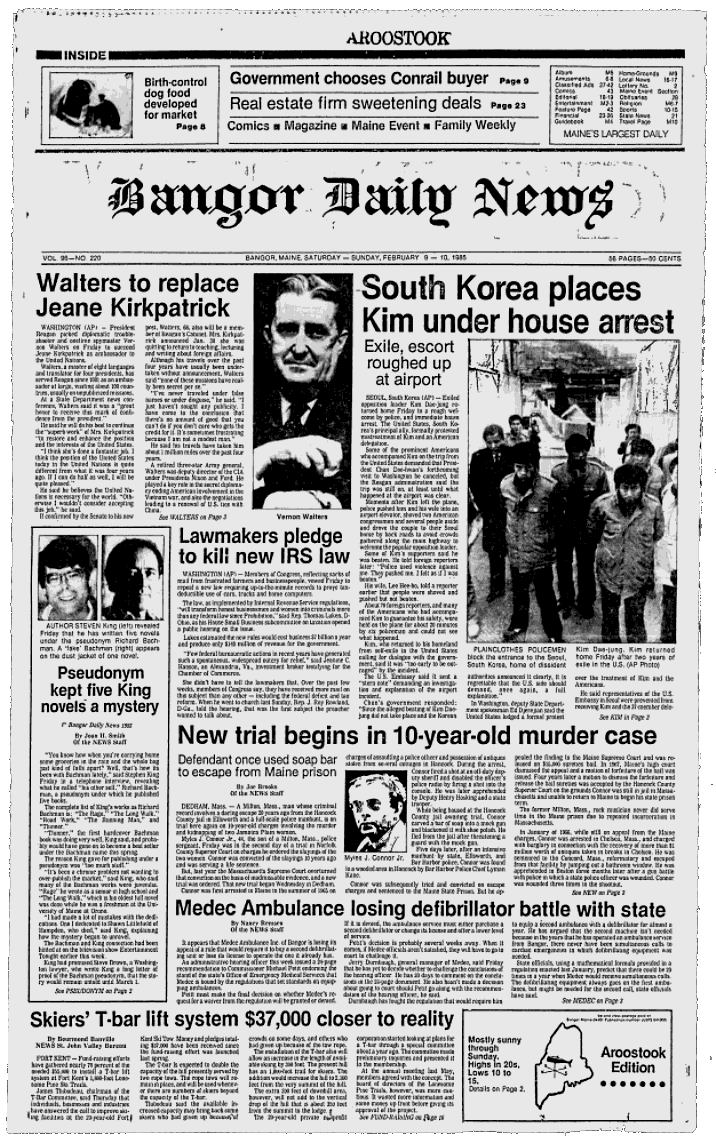 Stephen King initially intended to use ”Gus Pillsbury” as a pen name; that name had belonged to his material grandfather. The manuscript for Bachman’s first novel, Rage, had made the rounds at New American Library’s editors under the title Getting It On, and with ”Guy Pillsbury” given as author, but when it became known that King was in fact its author, he quickly withdrew it but resubmitted it under its new title. When the publisher later asked which name to put on the book, King on the spur of the moment gave them the name ”Richard Bachman”.
Stephen King initially intended to use ”Gus Pillsbury” as a pen name; that name had belonged to his material grandfather. The manuscript for Bachman’s first novel, Rage, had made the rounds at New American Library’s editors under the title Getting It On, and with ”Guy Pillsbury” given as author, but when it became known that King was in fact its author, he quickly withdrew it but resubmitted it under its new title. When the publisher later asked which name to put on the book, King on the spur of the moment gave them the name ”Richard Bachman”.Many have wondered why King wrote novels under a pen name. This is his own version of it, as published on his home page:
“I did that because back in the early days of my career there was a feeling in the publishing business that one book a year was all the public would accept but I think that a number of writers have disproved that by now. I'm one of them and the guy who writes the Along Came the Spider books is another one who's written two or three books a year. Danielle Steel usually publishes two books a year. So, the public will accept more than one book from a writer in the course of a year. The thing is one book is all most writers want to produce or can produce in the course of a year and some of them only publish a book every two years. Ed McBain is another novelist who publishes multiple books in some years and his original name was Evan Hunter. That's the name he's always published under, and he adopted the pen name of Ed McBain for the same reason I adopted Richard Bachman and that was that it made it possible for me to do two books in one year. I just did them under different names and eventually the public got wise to this because you can change your name, but you can't really disguise your style. The name Richard Bachman actually came from when they called me and said we're ready to go to press with this novel, what name shall we put on it? And I hadn't really thought about that. Well, I had, but the original name—Gus Pillsbury—had gotten out on the grapevine and I really didn't like it that much anyway, so they said they needed it right away and there was a novel by Richard Stark on my desk so I used the name Richard and that's kind of funny because Richard Stark is in itself a pen name for Donald Westlake and what was playing on the record player was "You Ain't Seen Nothin' Yet" by Bachman Turner Overdrive, so I put the two of them together and came up with Richard Bachman.”
 King dedicated the first four Bachman novels to persons close to him, which can be seen as taking an unnecessary risk. Not unexpectedly there were repeated rumors about King being Bachman, and he was repeatedly asked about it. In a letter dated in May 1981, King wrote:
King dedicated the first four Bachman novels to persons close to him, which can be seen as taking an unnecessary risk. Not unexpectedly there were repeated rumors about King being Bachman, and he was repeatedly asked about it. In a letter dated in May 1981, King wrote:“The rumor has gotten around that I am Richard Bachman, but it’s not true. I know him and I believe he lives in Connecticut – as I recall, he was a surly fellow.”
In August 1982, King again declared that he was not Bachman, though this time he also hinted at knowing the name was a pen name:
“I’m not Richard Bachman, but I know who he is, and I can’t tell. Professional ethics, and all that!”
Thinner was published in 1984, and two details in it are worth mentioning. One is that King at one point in the novel humorously refers to his own fame, writing, "You were starting to sound like a Stephen King novel for a while there..."
The other is the American edition of Thinner also, surprisingly, includes a couple of phrases in Swedish. What happened was that at one point in the novel, a curse is supposed to be expressed in Romani, a language which King is unfamiliar with. In a letter dated January 6, 1987, to his Swedish reader Lena Hansen, he tells us what happened:
Dear Lena Hansen,
I am sure this letter is coming to you long after you’d given up any hope of reply, but that is because I am a very sloppy correspondent. I was greatly amused by your letter, although it called on an old embarrassment to memory. When you say the words which are supposed to be in Romany are really in Swedish, you are right. When I needed a phrase, I simply picked one that sounded good from the Swedish copy of THE SHINING which happened to be lying on my desk. I then got in touch with a professional researcher, and asked if, for a price, he could find somebody to translate a number of English phrases into Romany. The phrases, of course were the ones you mentioned: White man from town, gypsy pie, and so on. In other words, the Swedish words were simply place-holders. I intended to take them out and replace them with the actual Romany. My researcher never replied. In the end, the book went out with all the crazy Swedish. But since very few people read both languages, yours was only the second letter I’ve gotten on this subject although the book has sold over two million copies.
Best wishes,
Stephen King
P.S. I am including a copy of VARSEL from which the notorious? / famous words and phrases were drawn.
Due to this, we find phrases like, ”Ta mig inte till mormor” (literally: ”Don’t bring me to grandma”) and ”Skummade igenom” (”Skimmed through”) in the American version of Thinner. In the Swedish translation, they were replaced by nonsense words.
The Thinner hardcover jacket also carries a photo of Richard Bachman. But the man depicted is actually Richard Manuel, a friend of King’s literary agent, Kirby McCauley. Manuel lived in Roseville, Minnesota, a suburb adjacent to St. Paul and Minneapolis, and worked with energy-efficient housing. He has later said that he told nobody, not even his sister, about his portrait being used in the book:
”I didn't tell anybody, I was sworn to secrecy. Some friends called and said 'Hey, Dick, there's a guy that looks like you who's writing books in New Hampshire.' Even my sister called and said that.”
McCauley said that he and King picked Manuel because ”we had to find someone who lived a long way away from New York. There would have been a chance that someone in New York would recognize Richard Bachman walking down the street.”
In spite of all caution, however, what should not have happened happened. Someone found evidence for King being Bachman. The man who did so was Stephen P. Brown, and in an article in Washington Post, April 9, 1985, two months after King himself had publicly admitted to being Bachman, he described what had happened:
“Novelist Richard Bachman died of exposure early this year.
I helped kill him.
My involvement began while I read Bachman's five novels. Gradually it dawned on me that they could have been written only by one man, and it wasn't Richard Bachman. It had to be Stephen King, the self-described "literary equivalent of a Big Mac and a side of fries" who had become one of America's most popular living writers.
My suspicions drove me to the Library of Congress for a look at Richard Bachman's copyrights. All but one was in the name of Kirby McCauley, who is King's agent. But the earliest of the Bachman books, "Rage," was in King's own name. I sent him a letter detailing what I had found and waited for a dissembling reply. Instead, one day, the phone rang.
‘Steve Brown? This is Steve King. Okay, you know I'm Bachman, I know I'm Bachman, what are we going to do about it? Let's talk.’”
In the end, King chose to openly admit to being the author of the Bachman novels in an interview with Bangor Daily News from February 8, 1985.
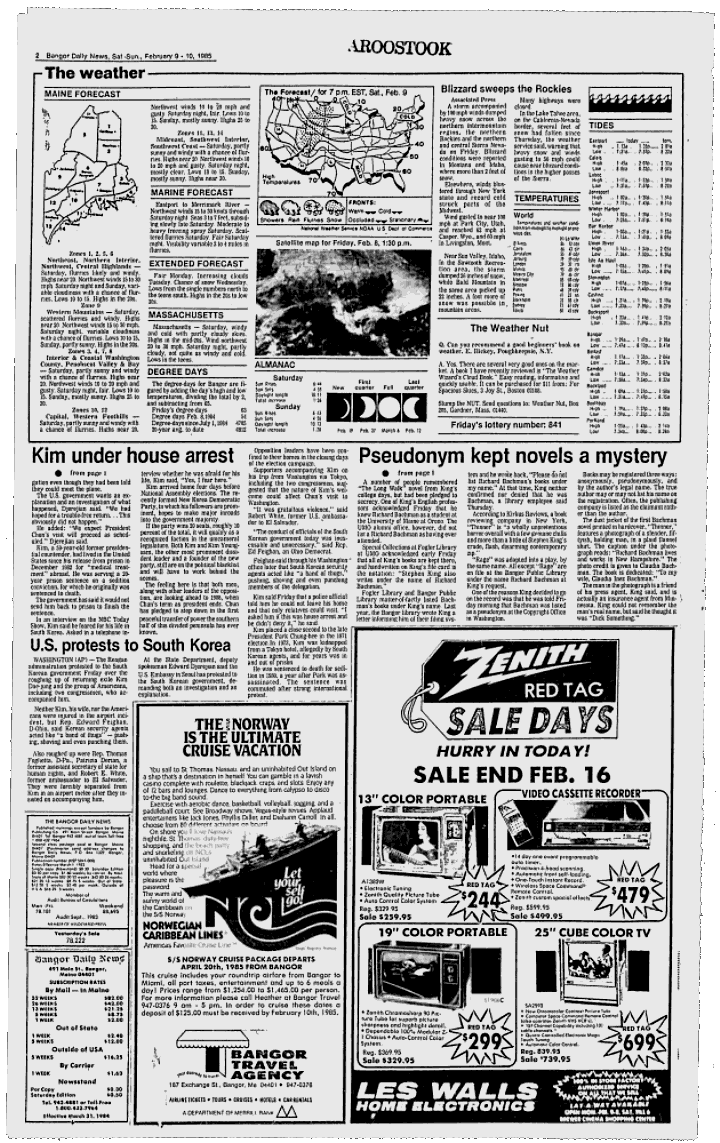 What could we have expected if Bachman’s real identity had never been disclosed? King has stated that he hoped for his novel Misery (1987) to be the book that would take Bachman to the bestseller lists. In his postscript to Nightmares & Dreamscapes (1993), King writs that he had been working on two further Bachman novels. One of them was called My Pretty Pony, and was a gangster novel, but in the end King felt that he was unable to write the book he had envisioned and discarded all of it apart from a single flashback scene which was published under the My Pretty Pony title, initially as a limited edition of only 250 copies, illustrated by artist Barbara Kruger and published by the Whitney Museum of American Art in New York City. It was later reprinted, both as a standalone book and as one of the stories in King’s Nightmares & Dreamscapes collection.
What could we have expected if Bachman’s real identity had never been disclosed? King has stated that he hoped for his novel Misery (1987) to be the book that would take Bachman to the bestseller lists. In his postscript to Nightmares & Dreamscapes (1993), King writs that he had been working on two further Bachman novels. One of them was called My Pretty Pony, and was a gangster novel, but in the end King felt that he was unable to write the book he had envisioned and discarded all of it apart from a single flashback scene which was published under the My Pretty Pony title, initially as a limited edition of only 250 copies, illustrated by artist Barbara Kruger and published by the Whitney Museum of American Art in New York City. It was later reprinted, both as a standalone book and as one of the stories in King’s Nightmares & Dreamscapes collection.The second Bachman novel King had worked on was called Machine’s Way and was according to one rumor intended to be published as by ”George Stark”, who was supposed to be a pen name for Richard Bachman. Parts of that book in the end turned up in King’s novel The Dark Half (1989), which King initially wanted to publish as a collaboration between himself and Bachman. It wasn’t, but King has said that he was inspired to write it by his Bachman experience, and it is dedicated to ”The late Richard Bachman”.
After Bachman’s ”death”, two novels have been published under his name, The Regulators and Blaze. When the books were published, in respectively 1996 and 2007, far from all readers knew that Bachman was a King pen name; quite a few visitors to my Internet site asked me who Bachman was and what his relationship to King was.
In fact, both novels are the final versions of earlier King writings. The Regulators began as an original feature film manuscript, which director Sam Peckinpah read and wanted to make. But Peckinpah died in late December 1984, while King was working on a second draft of his manuscript. Blaze, in turn, was initially written already in 1973, years before Carrie had been published. But for its publication 34 years later, King rewrote and updated it extensively.
In 1985, an omnibus volume called The Bachman Books and containing the first four Bachman novels was also published by Stephen King’s paperback publisher, New American Library. But on April 26, 1988, Jeffrey Lyne Cox held 60 students hostage at San Gabriel High School in San Gabriel, California, for over half an hour, though nobody was injured. A friend of Cox told reporters that Cox had been inspired by Rage, which he had read repeatedly and strongly identified with. Not much later, a copy of Rage was found among the possessions of Dustin L. Pierce, who on September 18, 1989, took a shotgun and two handguns to school and held a history class at Jackson County High School in McKee, Kentucky, hostage during a nine-hour standoff with the police. Again, nobody was injured, but due to his owning the novel, speculations that Pierce also had been influenced by the book began to circulate.
On September 11, 1991, Ryan R. Harris entered a mathematics class in Stevens High School in Rapid City, South Dakota, pulled out a sawed-off shotgun, ordered the teacher to leave and held the rest of the class hostage for four hours. Once again nobody was hurt, but Harris was also said to have been inspired by Rage. Then on January 18, 1993, Scott Pennington walked into an English class at East Carter High School in Grayson, Kentucky, armed with his father’s revolver. He shot his teacher Deanna McDavid dead, then also killed school custodian Marvin Hicks and held the class hostage for twenty minutes. Shortly before the shooting he had written a book report on Rage and was upset when Ms McDavid had given it a C grade.

Finally, in December 1997, came the Heath High School shooting in West Paduch, Kentucky, where Michael Carneal shoots eight of his fellow students; three of them died. In his school locker, Carneal had a copy of The Bachman Books edition including Rage. After this incident, Stephen King decided to let the book go out of print as an individual title, and to remove it from future printings of The Bachman Books. In a footnote to the introduction to Blaze, the seventh and so far, latest Richard Bachman novel to be published, King heaved a sigh of relief concerning Rage:
”Now out of print, and a good thing.”
The ”Richard Bachman” name has appeared several times in other and less depressing connections. For instance, in an episode named ”Caregiver”, aired in season 3 of the series Sons of Anarchy on the cable network FX, Stephen King has a cameo part as a cleaner who helps others get rid of corpses. The cleaner’s name is given as Bachman. And when The Running Man was filmed (premiered in 1987), King insisted that Bachman’s name was the only one given to the author on whose book the film was based.
Will there be more from Bachman. I believe there will, and that he is far from gone forever. My bet is on him having hidden away at least one more book somewhere.
Movie adaptation of both The Running Man and The Long Walk will be released in 2025 and in the first we’ll see actor David Zayas (Angel Batista on Dexter) as Richard Manuel who is also the name of the man posing as Richard Bachman on the cover of Thinner.
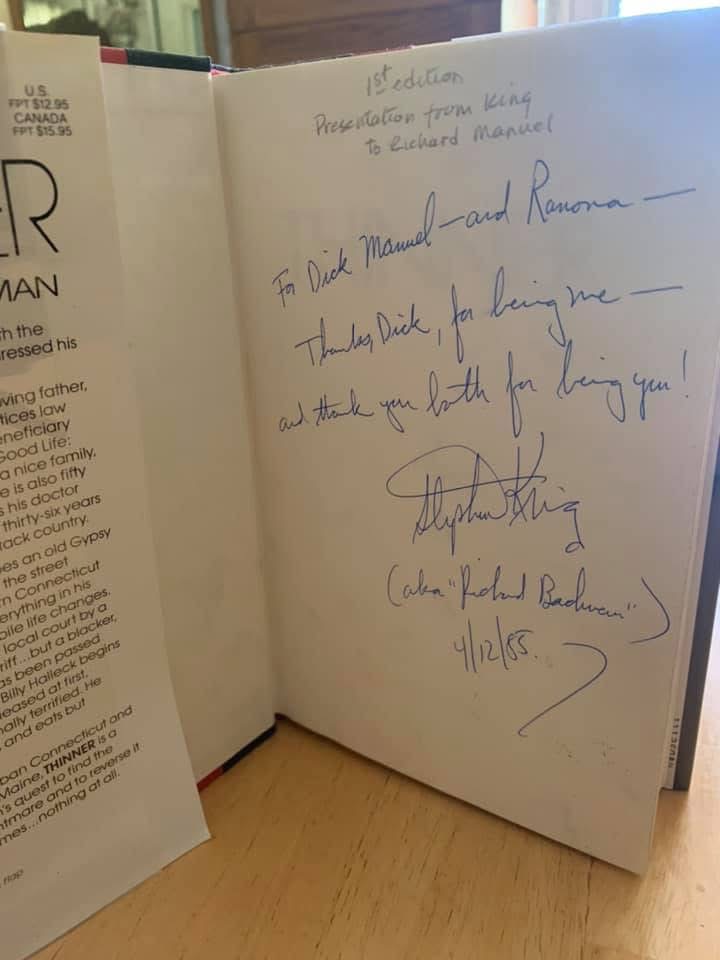
Richard Bachman links
Richard Bachman
Bachman Exposed by Steve Brown
The Importance of being Bachman by Stephen King

